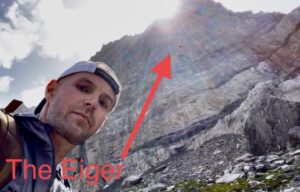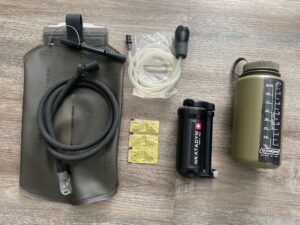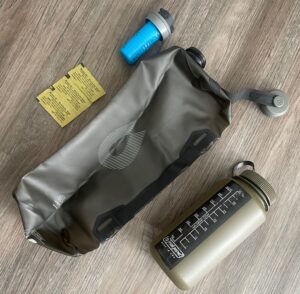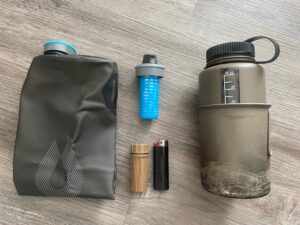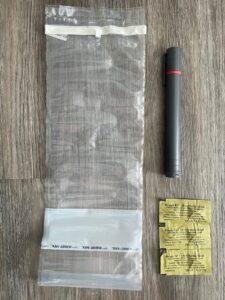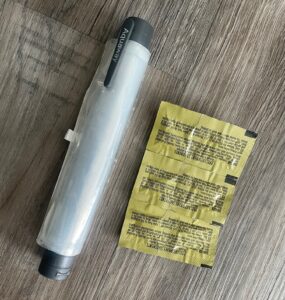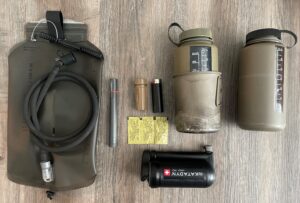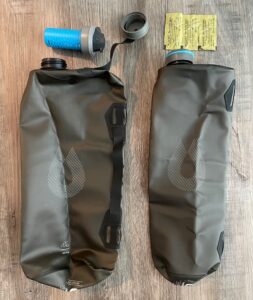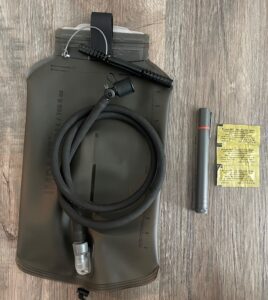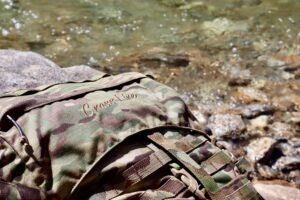Water is life’s matter and matrix, mother and medium. There is no life without water. For many years astrophysicists and cosmologists have hypothesized about the potential for life on other planets. Even for our closest planet Mars, we have debated whether life at one point could have existed. The interesting thing is that these scientists all agree on one thing, to find life on other planets we must first search for the presence of water, because where there is water, there is the potential for life.
A human can survive approximately 3 minutes without oxygen, 3 days without water and 3 weeks without food. Ironically, we not only need water as a necessity for our survival, we are comprised of 60% water, let that sink in. Many of us at Crossfire have extensive experience in the backcountry, conducting everything from military operations to summiting mountains. Countless times we have found ourselves many miles from civilization without cell coverage, relying solely on the equipment in our packs and the knowledge we have gained through education and first-hand experience. Naturally, for our first blog post we have decided to talk about what we think is the most important requirement for life, water.
Finding yourself in the wilderness, whether for work while wearing a uniform and flag, or for adventure paddling through the Amazon rainforest, can bring many risks which should be safely managed through preparation. Dehydration should never occur if proper preparation and planning is taken. 71% of the Earth’s surface is comprised of water, the oceans make up 96.5% of that water, therefore only 3.5% of that water is fresh water and nearly all of which isn’t immediately drinkable without treatment.
Planning and Preparation
Many documented survival situations could have been completely avoided if proper planning and preparation was taken. When it comes to hydration, we believe in not only having proper equipment, but also knowledge and wisdom. There are many inexpensive products on the market today which are small, lightweight and effective at producing drinkable water, yet if they are left at home, they are as effective as a fishing hook in the desert. Complacency has brought many adventures to a tragic end. Don’t become complacent, plan and prepare.
Knowing the time required in the field and available local fresh water is the starting point. For example, if my trip was for 1 day, I could technically pack enough water in a reservoir to sustain myself for that time. However, if this was my plan, it would be piss poor. What if the canteen had a crack, or the bladder sprung a leak. What if I stumbled across another person in need of aid. What if I became lost or injured? There are many “what ifs” which could be mitigated by having redundancies built into the plan.
1. Bring at least two sources to contain water, it’s better to have two containers at 1qt each than one container at 2qts.
2. Include one of those containers to be made of metal (if possible) which can be boiled over a fire.
3. Have at least two ways to make fire, rubbing sticks and striking flints doesn’t count. They are ancillary to the main two (for another blog post).
4. Know where the local water sources are. Are you in an area with streams and springs, or the desert; Is it the dry season or the wet season? There have been many times where I have found myself visiting an area a year later, planning to fill up at that spot on the map which had a strong flowing stream to see it bone dry. Did I plan for that?
5. Bring two ways to purify water.
6. Have a way to collect the water and safely consume it without causing cross contamination between the potable water and the collected water containers.
7. Bring more water than you think you will need. It’s always faster and easier to drink what you have than to find a source to procure more from. Much like an aircraft preflight, have enough fuel to make the destination plus enough flight time to make the alternate.
Containers
There are countless ways one can store water, lightweight plastic water bottles, water bladders, canteens, Nalgene bottles, titanium canteens and even a zip-lock bag. They all have pros and cons, weighing these factors depending on the trip and duration will determine what is suitable. Use the motto “two is one, one is none”. However, try to avoid exact duplicates. Go with complimentary pairs where they share the same purpose but have secondary attributes to widen capability and complement each other.
Making potable water
Almost all waterborne pathogens and parasites are invisible to the naked eye, against popular belief seen on reality TV shows, almost all natural water sources found in the wild should be considered a potential source of contamination which can cause debilitating diseases. Contrary to what has been seen on TV, sipping from the moving part of the river or using your bandanna as a filter is like using a football net to stop a golf ball, mostly ineffective. Needless to say, drinking piss or squeezing the liquid from elephant dung is a recipe for disaster and we strongly suggest against it. Without one being an expert survivalist in water sources (with knowledge and education in that current geographical location) we highly recommend against any of these theatrics. Keeping it simple is the way to go.
Filtration – We suggest using a water filter which has a mesh of .02 microns (.0002mm) or smaller. Water filters are all designed to remove the nasties from the water source without any other treatment needed, these filters use a mechanical process much like a football being stopped by the net appropriate for its size. They range from packable hand pump filters geared towards filtering large quantities of water for multi-day uses, to small pen size straws for on-the-move filtration. This technology has been around for several decades, most reputable brands should take good care of your GI tract. Filtration is my preferred method of treating water, as only filters can remove turbidity from dirty water and remove any noticeable taste. I have filtered drainage puddles with tire tracks, muddy creeks, rivers, glacial run off and stagnant ponds safely. After proper filtration you can transform, turbid parasitic laden pond water into crystal clear tasteless glacial water as if it was collected from a fissure shooting out from the side of the Eiger.
Chemical Purification – As a backup, carrying a few purification tablets in your pack or canteen pouch is an excellent choice. They can be used if the filter becomes clogged or breaks. Their advantage is that in tactical situations, quickly filling your bottles and moving to a safer location before disinfecting is far more appropriate than crouching down and pumping a squeaky filter with your back to any potential threat. Their disadvantage is that they cannot remove the taste or turbidity of water, they can take 30-60 minutes to render the water safe to drink and can have a strong chemical taste. This is why these are used as a backup to keep in several places on you and in your pack while in the wilderness.
Boiling – As a final resort, boiling is the only guaranteed way to destroy all waterborne pathogens from the murkiest of water. For water below 6,500ft bringing water to a rolling boil for 1 minute, and a rolling boil for 3 minutes above 6,500ft will destroy the RNA and DNA of anything which can make you sick. It’s really a last resort as this can be time consuming and tactically dangerous depending on the situation.
The most common nasties
Preventative measures are always the way to go, however, we are human. What if one day you forgot to let the tablets sit long enough or you forgot to use the inbound filter hose correctly and used it as the outbound hose? Remember it only takes a few organisms to make you sick.
Giardia – Is found literally everywhere. It hides even in high quality water sources. You cannot hide from this little guy. Giardia is a parasite which can cause mild symptoms to intense abdominal cramps and diarrhea. The symptoms can last for weeks and leave long term intestinal problems for the victim.
Cryptosporidium – Is another nasty parasite which causes GI symptoms similar to Giardia, crypto is especially nasty as it has been known to be highly resistant to chlorine water treatment, it can take higher doses of chlorine dioxide to cause deactivation. Those tablets in murky water sloshing around in your canteen better be strong to prevent a bout of cryptosporidiosis.
E. coli – Escherichia Coli is a bacterium with several strains. Some of which can actually be beneficial to gut health. That being said, we aren’t talking about those strains. An E.coli infection from contaminated water occurs where animal feces mix with the water source upstream. Just because the source looks clean doesn’t tell you where it came from. Knowing my luck, just 100 yards upstream a moose dropped a deuce into my water.
Typhoid – The bacterium Salmonella typhi is responsible for this terrible disease which can cause an array of debilitating symptoms from loss of body weight to fever. Without prompt treatment it is estimated 1 in 5 people will die from this disease.
Cyclosporiasis – Again another organism which can be parasitic to humans ingested through feces contaminating water. It can take weeks of diarrhea and cramping to resolve. Just like the weeks of loaf pinching that deer did to put it into the numerous streams in your AO, treat that water.
The right tool for the job – with the array of equipment on the market, here is what we suggest as pairings depending on the mission requirement or activity. To pair we suggest two forms of purification and two forms of containers. If pairing with boiling as a form of purification we recommend two forms of fire making, matches and lighters – not rubbing sticks together. The fact that these two items are miniscule for weight and size, I suggest bringing them regardless as an extra redundancy.
Figure 1 –
Contents: Soft water bladder, hard water bottle, filter which can fill both containers, purification tablets which can fill both containers.
Figure 2-
Contents: Soft water bladder, hard water bottle, filter which can fill both containers, purification tablets which can fill both containers.
Figure 3-
Contents: Soft water bladder, hard water bottle, filter which can fill both containers, the ability to boil using fire and the titanium cup
Figure 4-ULTRALIGHT EMERGENCY
Contents: Water bag, filter straw, purification tablets (excellent to keep in a cargo pocket as the “final straw” emergency backup.)
Figure 5-Long durations in the field
Figure 6-Mountain races
These are only examples of building redundancies into your water system, depending on the variable requirements of duration, speed, tactical considerations, weight, distance from water sources and distance from your rescue, we suggest formulating a system which gives you enough gas to make the destination and to your alternate airport with or without failures.
Stay hydrated friends!

